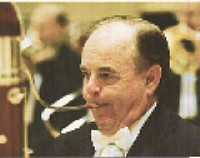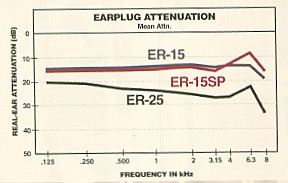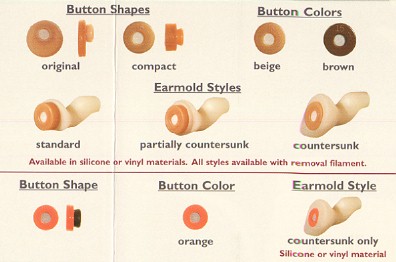THE MUSICIAN'S EAR
by Ellie Apuzzo
Noise induced hearing loss can happen to anyone in contact with loud
music. Learn the hazards and how to protect yourself!
Quality Protection
The last thing, a travel weary, instrument lugging, rehearsal haggard,
make-ends-meet musicians want is another thing to worry about and
invest in. But there is one. Perhaps the most important one.
 Risk to hearing may
Risk to hearing may
actually be greater for
orchestral musicians. . .
|
Their hearing. Years of loud music takes its toll and every
musician's hearing is at risk. The fact that excessive exposure to
high levels of music can cause hearing loss is supported by dozens of
studies dating back more than 30 years. And this may come as a
surprise: the music genre is irrelevant. Risk to hearing may
actually be greater for orchestral musicians than it is for the rock
and roller. (One study suggests that up to 52% of classical musicians
suffer job related hearing loss.)
Here are some statistics. Musicians routinely face sound pressure
levels in potentially hazardous ranges. They extend up to 120-130
decibels while 3 feet from the speaker in amplified rock/pop bands,
83-112 decibels on stage in various orchestras and 80-101 decibels on
stage in jazz, blues, and country and western bands. That reality,
plus the fact that many musicians practice and/or perform 4 to 8 hours
a day, suggests a strong causal relationship between their chronic
loud music exposure and their "noise-induced hearing loss (NIHL)."
How do these numbers effect a musician's life and profession? Let's
take a look. It is widely known that difficulty in speech
comprehension seen in NIHL is secondary to hearing loss in the high
frequencies.
High-frequency hearing loss
is particularly detrimental
for musicians and singers
because . . .
|
At first, the high-frequency loss may be mild enough not
to cause any problems but as exposure continues and loss progresses,
understanding certain words, especially in the presence of background
noise, may become increasingly difficult. Distinguishing certain
consonant sounds (i.e., "s" and "f") of higher frequencies and the
higher pitched women and children's voices may become more difficult
too. The performing artist is not immune to these frustrating
consequences . . . in social context or at work. High-frequency
hearing loss is particularly detrimental for musicians and singers
because they not only need to understand conversational speech but
they must match frequencies over a broad range, including frequencies
above those required for understanding speech. High-frequency hearing
loss may lead to:
-
excessively loud playing at higher pitches,
-
arm and wrist strain (i.e. a violinist) in order to compensate, may
"overbow", and lastly,
-
music takes on a distorted sound losing
it's color and clarity due to the high-frequency loss.
For the
singer, monitoring of one's voice is essential during singing in
allowing for vocal adjustments. Impaired self-monitoring caused by
hearing loss or trying to sing over background music that is too loud
can lead to vocal abuse. This in turn can lead to the development of
dysphonia from associated vocal cord inflammatory pathology (i.e.,
nodules, polyps etc.).
A musician's hearing loss
is often asymmetric
|
A musician's hearing loss is often asymmetric, probably relating to
the position of the instruments and/or amplifiers on the stage. The
rock drummer, tends to be worse in the left ear owing to its closer
proximity to the high-hat cymbals. In the violinist also, it is more
often the left ear that will be effected, but the flute and piccolo
players experience greater loss in the right ear. This imbalance
often cause the musician to complain of distortion, even in their
better ear.
 What can be done? I'm glad to be able to offer some possible
solutions. There are plugs that musicians' can wear that will help to
protect their hearing while allowing the music to come through. The
plugs are custom made and are far from the
perceived "stuff-it-in-your-ear" complete muffling type of ear
protection. One company which offers this product is Etymotic
Research. They developed and patented the attenuator used in
Musicians Earplugs. The attenuator serves to filter incoming sounds
and gently reduces the intensity. The ER-15 attenuates oncoming sound
by 15 decibels, the ER-25 by 25 decibels, and the newest addition is
the ER-9 which will reduce the incoming signal by, you guessed it, 9
decibels. All of these attenuator "buttons" can be used,
interchangeably, in the same custom made earmolds. The molds are made
of one of two materials, vinyl or silicone. The silicone is softer
and usually more comfortable to wear. The plugs are designed to
maintain high fidelity reproduction of music without compromising the
musician's ability to listen. Music and speech can still be heard
clearly, but will not be as loud. A lower cost alternative is the
ER-20 HI-FIT, a non-custom plug.
What can be done? I'm glad to be able to offer some possible
solutions. There are plugs that musicians' can wear that will help to
protect their hearing while allowing the music to come through. The
plugs are custom made and are far from the
perceived "stuff-it-in-your-ear" complete muffling type of ear
protection. One company which offers this product is Etymotic
Research. They developed and patented the attenuator used in
Musicians Earplugs. The attenuator serves to filter incoming sounds
and gently reduces the intensity. The ER-15 attenuates oncoming sound
by 15 decibels, the ER-25 by 25 decibels, and the newest addition is
the ER-9 which will reduce the incoming signal by, you guessed it, 9
decibels. All of these attenuator "buttons" can be used,
interchangeably, in the same custom made earmolds. The molds are made
of one of two materials, vinyl or silicone. The silicone is softer
and usually more comfortable to wear. The plugs are designed to
maintain high fidelity reproduction of music without compromising the
musician's ability to listen. Music and speech can still be heard
clearly, but will not be as loud. A lower cost alternative is the
ER-20 HI-FIT, a non-custom plug.

Production Quality
Ear Monitors are fast becoming popular as an on-stage aid to
performing artists. These in-the-ear monitors benefit the performer
in sound quality, clarity, and performance. In other words, they hear
themselves more clearly.
. . . the use of ear monitors
also raises a serious question
about benefit versus risk
|
However, the use of ear monitors also raises
a serious question about benefit versus risk. A custom-fit monitor
has the capability of significantly reducing the amount of ambient
stage noise that the performer hears, and thus extends safe exposure
time to harmful loudness. The down side is that most monitors
currently available on the market have the ability to cause hearing
damage if the volume levels or "mix" is not carefully controlled.
There are three general types of personal ear monitors to choose from:
completely custom earpieces, occluding modular designs, and
non-occluding modular designs. One popular custom monitor currently
seen in the professional touring category, the Ultimate Ears UE5 Pro,
is manufactured at Westone Laboratories. That design places two
drivers with a passive crossover in the earpiece for exceptional sound
quality and clarity. A special acoustic seal allows the artist to
have a lower "at ear" volume, even on high-volume stages.
Modular occluding (sealed ear) designs are based on earpieces that can
be used either with generic foam tips or with an earmold. Examples
include the Shure Bros. models E1/E5 and the Sensaphonics Pro-Phonic
4.
Modular non-occluding (partially open ear) designs are usually used
with commercially designed earbuds. The earpieces can be custom
molded or generic fit. These products should be limited to the
quietest of performance venues as there is little ambientnoise
reduction. When used in louder venues, there may be a tendency to
operate the monitors at an extreme level in an attempt to mask the
ambient noise.
Every study confirms that excessive loudness, over time, results in
hearing loss. And hearing loss effects every aspect of a musician's
career. But noise-induced hearing loss can be prevented, and proper
prevention should begin with the school band member and carry through
to the touring professional. For more information, call the
Hearing Aid
Center of Orange County
at 845-564-1593, or visit the
Westone website.
|



 Ellie Apuzzo owns and operates
Ellie's Consider It Done.
She provides
"on-site oversight for absentee owners" here in the Florida
Keys; and so far, this lifelong New Yorker just can't seem to
get into "Keys time!" Ellie can be reached at
ellie@elliesconsideritdone.com.
Ellie Apuzzo owns and operates
Ellie's Consider It Done.
She provides
"on-site oversight for absentee owners" here in the Florida
Keys; and so far, this lifelong New Yorker just can't seem to
get into "Keys time!" Ellie can be reached at
ellie@elliesconsideritdone.com.